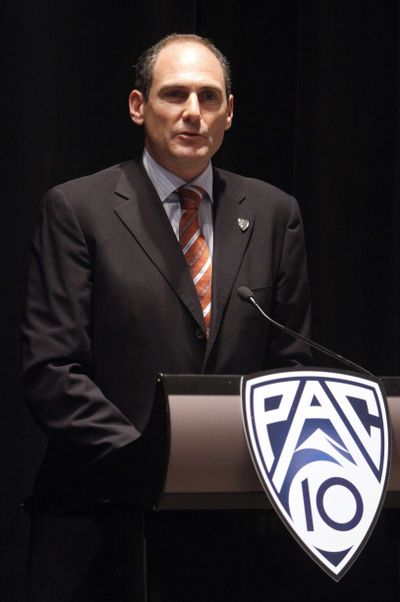Pac-12 set to cash in with new TV deal

SAN FRANCISCO – The Pac-10 has spent more than a year preparing for this moment when it can put its television rights up to bid on the open market for the first time since its expansion.
With Fox’s exclusive negotiating window expiring Thursday, the conference can now shop the rights to some 2,700 events a year and a possible partnership in a Pac-12 network to a bevy of interested media and technology companies.
The conference has 12 teams with next season’s additions of Utah and Colorado, covers one-fifth of the country and is the last major college property on the market for at least a few years.
That is expected to lead to fierce bidding from incumbents Fox and ESPN, as well as Comcast and Turner Sports, that could make the Pac-10 one of the highest revenue-producing conferences in the country. It’s the second lowest now.
College sports have fared well on the market in recent months, with the ACC reportedly getting $155 million a year for its rights and the Big 12 close to finalizing a deal with Fox, according to the Sports Business Journal, that will make its total annual package worth about $130 million.
That’s less than the behemoths from the SEC ($205 million) and Big Ten ($220 million) but far more than the less than $60 million the Pac-10 pulled in this year.
“Despite the recession, it seems like sports programming costs continue to escalate through the roof,” said Derek Baine, an analyst at the research firm SNL Kagan.
While Pac-10 commissioner Larry Scott has not publicly discussed what he believes he can get in the new deal, he clearly is shooting high. One key mark will be $170 million per year, because USC and UCLA would get $2 million bonuses until that level is reached.
“You’ve seen every conference significantly increase their value and that’s because ratings are tremendous,” Scott said. “If you compare the ratings and value in college sports to the NFL, proportionally based on ratings and viewership, college sports, even with some of the record deals we have seen recently, are still undervalued.”
Scott has laid out three major goals he’s looking to satisfy in a new television deal: increase revenue; increase national exposure for football and men’s basketball; and create a new network to promote women’s and Olympic sports.
The conference has expressed a willingness to move to more flexible scheduling to increase revenue and exposure. There has already been an increase in Thursday night football games and the schools are willing to abandon the traditional Thursday-Saturday basketball schedule that has limited broadcast windows.
The Pac-12 is well-positioned as the last major conference to put its product up for bid at a time when Comcast and Turner appear poised to try to make a splash in the college market.
Fox has already decided to put college football games on FX in 2011 after not airing sports on the network since 2006 and could use a long-term deal with the Pac-12.
Comcast already has a cable sports network in Versus, which shows some college football. and basketball, as well as NHL, IndyCar racing, cycling and other minor sports.
While the most publicized move was the expansion, it was a decision a few months later that was even more important. The 12 schools agreed in October to give the conference all their television, digital, sponsorship and properties rights.
That means that anyone who wants to broadcast – or even stream online – one of the 2,700 annual sports events must get the rights from the conference – a key step in making a network work.
It’s a big difference from the Big 12, where Texas is starting its own network separate from the rest of the conference.
“It was absolutely essential that they held their conference together and didn’t allow a high-profile school to split off,” said Steve Solomon, the president of media consulting firm SJS Sports and a former ABC and NHL executive. “Because of the power in both the San Francisco and L.A. markets, they have the opportunity for their own network. But they will still have challenges with distribution.”
That was a hurdle the Big Ten dealt with when it launched its network in 2007. It took a year to get deals to appear on all the major cable systems in the conference’s territory but now it’s a major reason the conference takes in more money than any of its competitors.